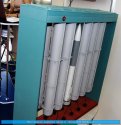Russian missile seems to be 92 pixels in diameter, with inner width of the cell (not the circular missile container!) some 177 pixels. That would amount to 0.65 meters if missile 0.34 m in diameter.
There is absolutely no engineering reason why hhq16 could not be stored and fired from rectangular containers. standard missile, sea sparrow missile, aster, they're all fired from such containers.
reason for circular container may be commonality with hq16, and thus some cost saving. but that too makes little sense since hhq16 is hot launched, so most of the commonality is thrown out of the window anyway.
HAD hhq16 been made to be cold launched, than circular container makes perfect sense. It takes less space, meaning the gas generator can be made smaller than if the gas it had to fill a larger, rectangular space (less pressure in that case). And rectangular container is not as structurally strong, requiring extra braces, probably taking a bit more width and making the container heavier.
but, since hhq16 is hot launched, there's really no reason not to have it maximize the use of the cell. Heck, even the missile alone could have been made a bit more efficient, being lighter, as no/less weight would be spent on hinged fins. (perhaps fins could be made so they don't fold at all and still fit inside the container).
Years ago, i thought h/ajk16 launcher was tailor made around hhq16. it made sense somehow. but now it seems that's not the case. so either there is another weapon around which the launcher was tailor made around... OR it really is about miniscule savings and cutting corners, while losing the potential to either have slightly better weapons or have the whole VLS cell smaller and lighter.
While it's possible it was sized for some non-defined future growth potential, that doesn't seem likely, as we're talking about a 10+ year old system. Usually one would size up launchers for at least something in development, not for something completely non-defined.








